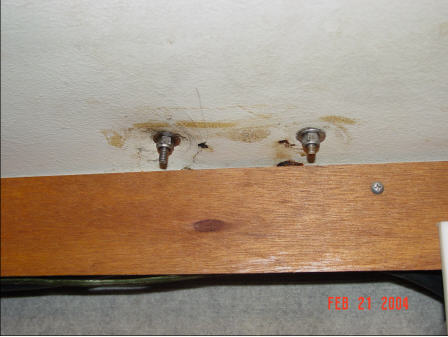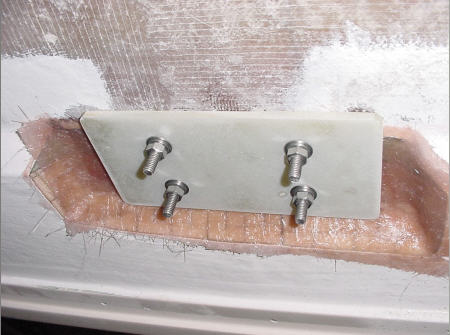“Mounting hardware directly through cored decking without taking the proper precautions is just asking for trouble. Here a leaky lifeline stanchion has caused the coring beneath its base to rot. The mounting nuts are drawn up so tight they’re crushing the panel, no doubt an attempt by the owner to not only keep the stanchion from wiggling, but probably to try and stop the leak as well (note the inadequately sized washers and lack of a backing plate).
 Anytime you screw or drill through a cored panel, the first rule is properly sealing the core against moisture entry. There are a number of ways to do this, but the best one is to avoid breaching the core material in the first place. In a perfect world, your boat’s manufacturer has anticipated where all deck penetrations are necessary (stanchion bases, cleats, etc) and has “de-cored” these areas by reverting to solid fiberglass, allowing you to mount hardware without drilling into the core. But, in the case of new installations (particularly if you’re lucks like mine) your chances are slim-to-none that any of these areas will coincide with whatever aftermarket doo-dad you want to mount, meaning you’re going to have to do it the hard way. The good new is the hard way is fairly easy, as long as you have access to the underside of the deck where you’re doing the mounting.
Anytime you screw or drill through a cored panel, the first rule is properly sealing the core against moisture entry. There are a number of ways to do this, but the best one is to avoid breaching the core material in the first place. In a perfect world, your boat’s manufacturer has anticipated where all deck penetrations are necessary (stanchion bases, cleats, etc) and has “de-cored” these areas by reverting to solid fiberglass, allowing you to mount hardware without drilling into the core. But, in the case of new installations (particularly if you’re lucks like mine) your chances are slim-to-none that any of these areas will coincide with whatever aftermarket doo-dad you want to mount, meaning you’re going to have to do it the hard way. The good new is the hard way is fairly easy, as long as you have access to the underside of the deck where you’re doing the mounting.
What you’re going to do is a little de-coring of your own. The easiest way to remove coring is with a hole saw and a little caution. Let’s say you want to mount a new cleat on your foredeck, but the entire area is cored. First step is marking and drilling the appropriate sized bolt holes. Then, take a 2 inch hole saw (or larger, depending on the size of your backing washers) and remove the coring from the underside of the deck where each bolt is to be installed, being careful NOT to drill through or damage the upper layer of fiberglass (you also have the option of removing a single section of coring large enough to encompass both bolts). I find it works best to drill almost through the coring, but leave the last 1/4″ or so to be removed by hand (to avoid any chance of damaging that outer fiberglass layer).
Once the cutout and coring is removed, seal the exposed edges of the coring in the holes with thickened epoxy paste. Now all you have to do is mount the cleat using properly sized backing washers and a good bedding compound (under both cleat and washers) and Whaa-la! You’ve got a properly mounted cleat that won’t leak and has no chance of letting water into the core.
I like the above method of dealing with mounting holes in cored panels, but it’s not the only way to address the problem. An excellent reference for this and just about any other type of fiberglass repair or maintenance issue is “Fiberglass Boat Repair And Maintenance” published by Gougeon Brothers, Inc. (517) 684-7286. It’s a good how to booklet and well worth space on any vessel’s bookshelf.
“ The right way to do it. Here the deck beneath a lifeline stanchion has been “de-cored” to prevent water entry into the core (note the substantial backing plate).”
The right way to do it. Here the deck beneath a lifeline stanchion has been “de-cored” to prevent water entry into the core (note the substantial backing plate).”
